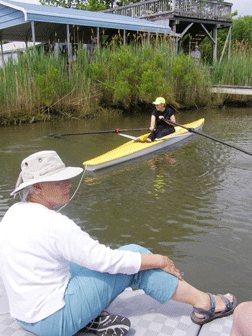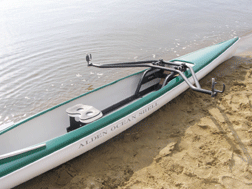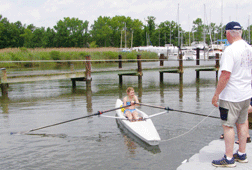
|
Volume 16, Issue 41 - October 9 - October 15, 2008
|
|
Columns |
Row, Row Your Boat
Like wind and engine power, human power can master the waves
 |
Wave Rowers hit the water, top.below Linda McCook of Edgewater demonstrates turning during group lesson with Lorna Perry. |
 |
by Dotty Holcomb Doherty
An early morning row on the Bay approaches nirvana. The glassy water captures each oar stroke in matching whirlpools beside your sun-speckled wake. Rhythmic motions evoke grace and athleticism as you glide over the water. Sounds become meditative: the light splash of the oars, the chunk of oarlocks, the metallic whoosh of the sliding seat. No one but you, the birds and the watermen.
Then the wind picks up. The satiny water surges. Motorboats jet by, adding cresting waves to the chop. These conditions can capsize scullers in racing shells. But your row does not have to end when sailors hoist their sails. Open-water boats thrive in the waves.
Nor do you have to row alone. As open-water rowing wins Chesapeake converts, Bay Country’s new Wave Rowers club welcomes rowers who enjoy companionship in their water workout.
From Rowboat to Speed Boat
Boats have been rowed for millennia — transporting wares, soldiers and fishermen — and raced nearly as long. But fixed-seat workboats like Grandpa’s dinghy and New Bedford whaleboats felt like plough horses to competitors wishing for a Thoroughbred. New designs in the 1800s — like oarlocks in outriggers instead of gunwales — transformed rowboats into sleek narrow shells, with thin coverings over internal frames. Sliding seats transferred power to the rower’s legs, changing the physics of rowing.
Speed was gained but stability was lost. The fragile racing boats needed calm waters to stay afloat.
In 1971, the first open-water shell, the Alden, added a new dimension to the sport. Sixteen feet long and 25 inches wide, the craft married stability with sliding-seat speed. To prove its seaworthiness, designer Arthur Martin rowed his Alden Ocean Shell into the 64-mph winds of tropical storm Doria. No longer were sliding-seat rowers confined to straight lines on flat water. Open-water rowing was born.
The Pull of Rowing
Starting in a seated crouch called the catch, Jean Tucker lowers her blades into the water and begins the drive by pushing back with her legs, arms straight. As her legs straighten, she leans back, pulling the nine-foot oars toward her ribcage. Feathering the blades out of the water, she reverses the pattern in the recovery: pushing with arms, leaning forward, then bending her legs to slide forward to the catch. The continuous motion is elegant, powerful and addicting.
This heady conversion of strength into grace and speed draws rowers to the water. Tucker went looking for them.
“I rowed around here for six months, alone,” Tucker says, “and I wondered where everyone else was.”
 |
Author Dotty Doherty’s Alden Ocean Shell, above, before a morning row on South River. |
Last December, “to get open-water rowers together,” she put up a website. Wave Rowers was the result. To join the club, new members go to the meetup website, where they sign up and learn about future gatherings. There are no fees, and everyone rows.
“You just show up with your shell and row,” says Tucker. “If we have boats to lend, we do.”
Seventy members have joined since December. Many discovered the club on the Internet’s Top 100 Rowing Sites. Some new to the sport discovered Wave Rowers on the Annapolis Meetups webpage or by tagging along with friends. Beginner Julie Salay of Kent Island came to the June meetup in Edgewater with rowing neighbor Sandy Janniche.
“I walked away from that day thinking how awesome it was,” Salay says. Her teacher, Californian JD Schaefer “was so positive,” she says. “He really helped me with my body position.”
Schaefer — an advanced rower on both flat and open water — found the club on the Internet. He drove 700 miles round trip — from North Carolina, where he was visiting — to attend the June gathering. His racing résumé includes Oregon’s 115-mile two-day Corvallis to Portland Row — appropriately acronymed CPR.
Another advanced rower traveled from Maine to teach.
Lorna Martin Perry, 64, the First Lady of open-water rowing, has been rowing the waves since her father, Alden-designer Arthur Martin, put a sliding seat in a redesigned kayak 40 years ago. Her lessons, like all Wave Rowers lessons, are free, and her quiet demeanor soothed nervous beginners.
“Always, always, always keep a loose grip on the handles,” Perry instructed. “The sooner you can make yourself relax in your grip, the easier it is to row. Relaxed hands equal a relaxed body.”
As you relax, she explained, your center of gravity sinks into the boat, and you become more stable, even in the waves.
Those waves are a siren song for some open-water rowers. By modifying the basic rowing stroke, they can adapt to constantly changing conditions. Others seek more peaceful venues, simply wanting to glide along quiet creeks. Tucker has adopted the term freestyle to describe what club members do.
“Freestyle doesn’t mean anything goes,” Tucker says. “It doesn’t mean willy-nilly. It’s a catchall for open-water rowing, flat-water rowing that’s not racing and extreme rowing — anything that’s a great distance. I want Wave Rowers to be all-inclusive.”
Meetup locations typically offer both open water and placid coves; rowers choose their routes.
 |
At Wave Rowers meets, everyone rows. Here 10-year old Kayla Kimble practices correct form as Kevin McCook watches. |
Tucker, who began rowing as a teenager in a cast-off wooden shell, sees even more potential with a new open-water shell, the Echo.
“When the wind is from the south here,” says Tucker, “and we get that 100 miles of fetch off the Bay, you can sweep across the front of one of those waves, kick out onto the back of another and work it like a half-pipe. I’m looking for the first Tony Hawks [famed extreme skateboarder] of rowing.”
Open-water rowers desire boats that can handle all these conditions but are also easy to transport. Thirty-seven years of crafting gives them many choices.
New Designs and Old Favorites
An Alden fan for many years, Lorna Perry now co-owns Echo Rowing with her brother Doug Martin and boat-builder husband, Ted Perry. Her brother designed the Echo, an 18-foot open-water shell that’s both stable and racing-shell fast, making it suitable for novices and competitors. Just how much chop can these boats handle? You’ve got to see it to believe it.
“If you go on the Echo rowing website, www.echorowing.com,” says Perry, “you’ll see me rowing in waves that were way bigger than the waves my dad was rowing in [during Doria]. So in a way, I have surpassed him in that, and I have surpassed him in the design of the boat with my brother Doug.”
Folding riggers make the Echo easy to cartop and carry, and the shell can be easily launched from the beach or dock. Its versatility in the waves made Tucker’s heart soar when she spied one at the October boat show two years ago.
“I have been waiting on this boat since I was 13,” she says.
If rowers need a more economical option, Wave Rower Brian Schexnayder — who loves to find and sell second-hand boats — will happily oblige.
He found the perfect boat for Sandy Janniche, who wanted a shell that she or her young sons could row. The old Alden, dubbed the Velveteen Rabbit, arrived patched with duct tape and fiberglass, sporting a pair of blue Crocs instead of Velcro foot holders.
“It is going to be perfect for us,” says Janniche. “I can let the kids use it and I’m not going to have to worry about it. A boat is a boat, and it rows.”
Rowing the Waves in Company
“We have all flavors of boats in the club,” Tucker says. The only stipulation: the boats must be built for open water. Members row in Echoes and Aldens. One member has a Virus, a shell with a fixed seat and moving riggers; another has a Maas shell. Some own handmade Chesapeake Light Craft shells, wooden works of art.
The meetups have toured Chesapeake Country, from Annapolis to Baltimore to Kent Island. In Edgewater, David Neff is creating the Selby Bay Rowing Center, specifically for open-water shells.
On Saturday, November 1, the club meets on Kent Island at Crab Alley Bay.
“I’ve been getting invitations a year in advance,” Tucker says. “We are going to be at the Anita C. Leight Estuary Center (in Abingdon) next year for their big annual wade-in. The center is part of the John Smith Trail, and I have some members that want to row the whole route.”
Some members rowed in the Wye Island Regatta September 13. Tucker foresees charity fundraising events for the Wave Rowers, planning an open-water row across the Bay in the next couple years. She also hopes to team up with the Annapolis Rowing Club, whose members row in racing shells, or skinny boats, for future activities.
Wave Rowers welcomes all rowers with open-water shells. Due to overwhelming response, Wave Rowers cannot add any more beginners until next spring. But if you’ve been rowing alone or have equipment pining away in a shed, join the group on the water: http://web.mac.com/sailorgrrl/Wave_Rowers/Wave_Rowers.html